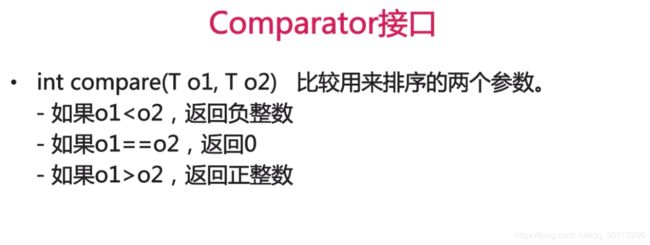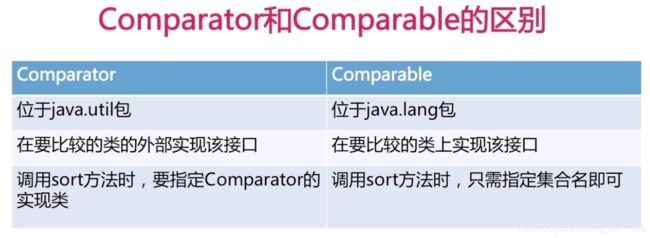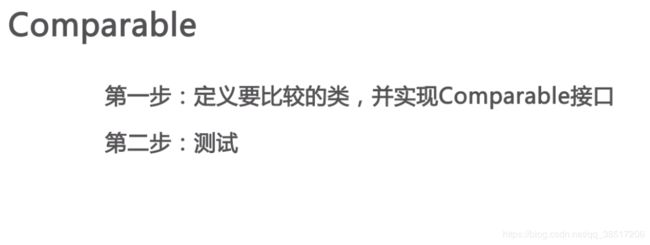Java常用工具类--集合排序
集合排序:
集合排序的方法:
案例:
例1:对存放在list的数据进行排序
代码:
package com.imooc.sort;
import java.util.ArrayList;
import java.util.Collections;
import java.util.List;
public class IntSort {
public static void main(String[] args) {
// 对存储在List中的整型数据进行排序
List list = new ArrayList();
list.add(5);
list.add(9);
list.add(3);
list.add(1);
System.out.println("排序前:");
for (int n : list) {
System.out.print(n + " ");
}
System.out.println();
System.out.println("*********");
// 对list中数据进行排序
System.out.println("排序后:");
Collections.sort(list);
for (int n : list) {
System.out.print(n + " ");
}
}
}
输出结果:
排序前:
5 9 3 1
*********
排序后:
1 3 5 9 例2:对存放在list的数据进行排序
代码:
package com.imooc.sort;
import java.util.ArrayList;
import java.util.Collections;
import java.util.List;
public class StringSort {
public static void main(String[] args) {
// 对存放在list的数据进行排序
List list = new ArrayList();
list.add("orange");
list.add("blue");
list.add("yellow");
list.add("gray");
System.out.println("排序前:");
for (String s : list) {
System.out.print(s + " ");
}
System.out.println();
System.out.println("*********");
// 对list中数据进行排序
System.out.println("排序后:");
Collections.sort(list);
for (String s : list) {
System.out.print(s + " ");
}
}
}
输出结果:
排序前:
orange blue yellow gray
*********
排序后:
blue gray orange yellow 对类的实例化对象进行排序:
Comparator接口介绍:
对宠物猫按照名称进行排序:
Cat类:
package com.imooc.sort;
public class Cat {
private String name;
private int month;
private String species;
// setter getter
public String getName() {
return name;
}
public void setName(String name) {
this.name = name;
}
public int getMonth() {
return month;
}
public void setMonth(int month) {
this.month = month;
}
public String getSpecies() {
return species;
}
public void setSpecies(String species) {
this.species = species;
}
// 无参构造
public Cat() {
super();
}
public Cat(String name, int month, String species) {
this.setName(name);
this.setMonth(month);
this.setSpecies(species);
}
// 重写toString
@Override
public String toString() {
return "[名字:" + name + ", 年龄:" + month + ", 品种:" + species + "]";
}
}
NameComparator类:
package com.imooc.sort;
import java.util.Comparator;
public class NameComparator implements Comparator {
@Override
public int compare(Cat o1, Cat o2) {
// 按名字升序进行排序
String name1 = o1.getName();
String name2 = o2.getName();
//若想逆序输出,加个 负号 就可以了
return name1.compareTo(name2);
}
}
测试代码:
package com.imooc.sort;
import java.util.ArrayList;
import java.util.Collections;
import java.util.List;
public class CatTest {
public static void main(String[] args) {
// 按宠物猫名字升序排序
Cat huahua = new Cat("huahua", 5, "英国短毛猫");
Cat fanfan = new Cat("fanfan", 2, "中华田园猫");
Cat maomao = new Cat("maomao", 3, "中华田园猫");
List catList = new ArrayList();
// 添加宠物猫
catList.add(huahua);
catList.add(fanfan);
catList.add(maomao);
// 输出排序前对象
System.out.println("按名字排序前:");
for (Cat cat : catList) {
System.out.println(cat);
}
// 输出排序后对象
System.out.println("按名字排序后:");
Collections.sort(catList, new NameComparator());
for (Cat cat : catList) {
System.out.println(cat);
}
}
}
输出结果:
按名字排序前:
[名字:huahua, 年龄:5, 品种:英国短毛猫]
[名字:fanfan, 年龄:2, 品种:中华田园猫]
[名字:maomao, 年龄:3, 品种:中华田园猫]
按名字排序后:
[名字:fanfan, 年龄:2, 品种:中华田园猫]
[名字:huahua, 年龄:5, 品种:英国短毛猫]
[名字:maomao, 年龄:3, 品种:中华田园猫]
对宠物猫按照年龄进行排序:
AgeComparator类:
package com.imooc.sort;
import java.util.Comparator;
public class AgeComparator implements Comparator{
@Override
public int compare(Cat o1, Cat o2) {
// 按年龄降序排序
int age1 = o1.getMonth();
int age2 = o2.getMonth();
return age2-age1;
}
}
测试代码:
package com.imooc.sort;
import java.util.ArrayList;
import java.util.Collections;
import java.util.List;
public class CatTest {
public static void main(String[] args) {
// 按宠物猫名字升序排序
Cat huahua = new Cat("huahua", 5, "英国短毛猫");
Cat fanfan = new Cat("fanfan", 2, "中华田园猫");
Cat maomao = new Cat("maomao", 3, "中华田园猫");
List catList = new ArrayList();
// 添加宠物猫
catList.add(huahua);
catList.add(fanfan);
catList.add(maomao);
// 输出排序前对象
System.out.println("按年龄排序前:");
for (Cat cat : catList) {
System.out.println(cat);
}
// 按年龄进行降序排序
System.out.println("按年龄降序排序后:");
Collections.sort(catList, new AgeComparator());
for (Cat cat : catList) {
System.out.println(cat);
}
}
}
输出结果:
按年龄排序前:
[名字:huahua, 年龄:5, 品种:英国短毛猫]
[名字:fanfan, 年龄:2, 品种:中华田园猫]
[名字:maomao, 年龄:3, 品种:中华田园猫]
按年龄降序排序后:
[名字:huahua, 年龄:5, 品种:英国短毛猫]
[名字:maomao, 年龄:3, 品种:中华田园猫]
[名字:fanfan, 年龄:2, 品种:中华田园猫]
编程练习:
要求:
定义一个学生信息类,包括学号,姓名,年龄三个成员变量,然后按名字进行升序排序。(使用Comparator接口)Student类:
package test013;
public class Student {
// 成员变量
private int id;
private String name;
private int age;
// 构造方法
public Student() {
super();
}
public Student(int id, String name, int age) {
super();
this.id = id;
this.name = name;
this.age = age;
}
// getter和setter方法
public int getId() {
return id;
}
public void setId(int id) {
this.id = id;
}
public String getName() {
return name;
}
public void setName(String name) {
this.name = name;
}
public int getAge() {
return age;
}
public void setAge(int age) {
this.age = age;
}
@Override
public String toString() {
return "[学号:" + id + ", 年龄:" + age + ", 姓名:" + name + "]";
}
// toString()方法
}
StudentTest类:
package test013;
import java.util.ArrayList;
import java.util.Collections;
import java.util.Comparator;
import java.util.List;
//实现Comparator接口
public class StudentTest implements Comparator {
// 实现接口中的方法
@Override
public int compare(Student o1, Student o2) {
String name1 = o1.getName();
String name2 = o2.getName();
return name1.compareTo(name2);
}
public static void main(String[] args) {
// 定义Student类的对象
Student stu1 = new Student(40, "peter", 20);
Student stu2 = new Student(28, "angel", 5);
Student stu3 = new Student(35, "tom", 18);
// 将对象添加到List中
List stuList = new ArrayList();
stuList.add(stu1);
stuList.add(stu2);
stuList.add(stu3);
// 输出排序前的数据
System.out.println("按名字排序前:");
for(Student stu:stuList) {
System.out.println(stu);
}
// 排序
Collections.sort(stuList,new StudentTest());
// 输出排序后的数据
System.out.println("按名字排序后:");
for(Student stu:stuList) {
System.out.println(stu);
}
}
}
输出结果:
按名字排序前:
[学号:40, 年龄:20, 姓名:peter]
[学号:28, 年龄:5, 姓名:angel]
[学号:35, 年龄:18, 姓名:tom]
按名字排序后:
[学号:28, 年龄:5, 姓名:angel]
[学号:40, 年龄:20, 姓名:peter]
[学号:35, 年龄:18, 姓名:tom]
案例:对商品价格进行升序排列
Goods类:
package com.imooc.sort;
public class Goods implements Comparable {
private String id;
private String name;
private double price;
// setter getter
public String getId() {
return id;
}
public void setId(String id) {
this.id = id;
}
public String getName() {
return name;
}
public void setName(String name) {
this.name = name;
}
public double getPrice() {
return price;
}
public void setPrice(double price) {
this.price = price;
}
// 无参构造
public Goods() {
}
// 多参构造
public Goods(String id, String name, double price) {
super();
this.id = id;
this.name = name;
this.price = price;
}
@Override
public String toString() {
return "商品编号:" + id + ", 商品名字:" + name + ", 商品价格:" + price;
}
@Override
public int compareTo(Goods o) {
double price1 = this.getPrice();
double price2 = o.getPrice();
return new Double(price1 - price2).intValue();
}
}
GoodsTest类:
package com.imooc.sort;
import java.util.ArrayList;
import java.util.Collections;
import java.util.List;
public class GoodsTest {
public static void main(String[] args) {
Goods g1 = new Goods("s0001", "手机", 2000);
Goods g2 = new Goods("s0002", "冰箱", 5000);
Goods g3 = new Goods("s0003", "电视机", 3000);
List goodsList = new ArrayList();
goodsList.add(g1);
goodsList.add(g2);
goodsList.add(g3);
// 输出排序前的数据
System.out.println("排序前:");
for (Goods goods : goodsList) {
System.out.println(goods);
}
// 输出排序后的数据
Collections.sort(goodsList);
System.out.println("排序后:");
for (Goods goods : goodsList) {
System.out.println(goods);
}
}
}
输出结果:
排序前:
商品编号:s0001, 商品名字:手机, 商品价格:2000.0
商品编号:s0002, 商品名字:冰箱, 商品价格:5000.0
商品编号:s0003, 商品名字:电视机, 商品价格:3000.0
排序后:
商品编号:s0001, 商品名字:手机, 商品价格:2000.0
商品编号:s0003, 商品名字:电视机, 商品价格:3000.0
商品编号:s0002, 商品名字:冰箱, 商品价格:5000.0
总结:











